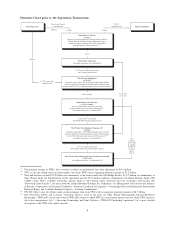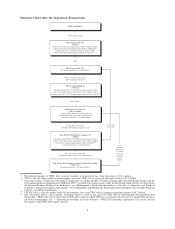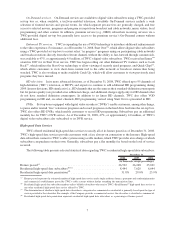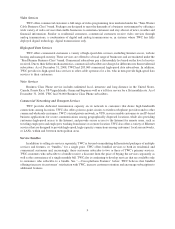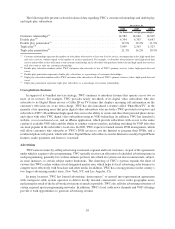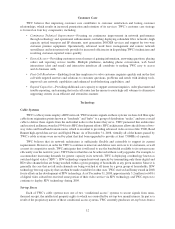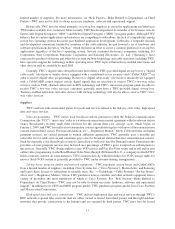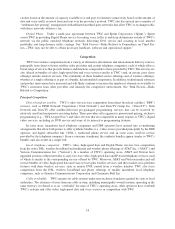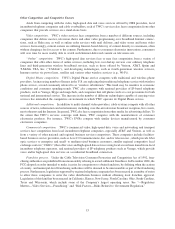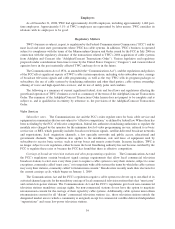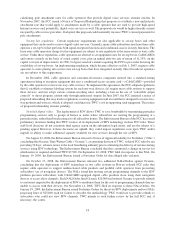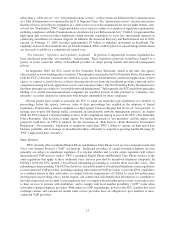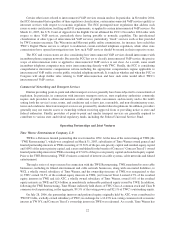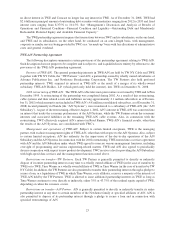Time Warner Cable 2008 Annual Report Download - page 23
Download and view the complete annual report
Please find page 23 of the 2008 Time Warner Cable annual report below. You can navigate through the pages in the report by either clicking on the pages listed below, or by using the keyword search tool below to find specific information within the annual report.limited number of suppliers. For more information, see “Risk Factors—Risks Related to Dependence on Third
Parties—TWC may not be able to obtain necessary hardware, software and operational support.”
Historically, TWC has also relied primarily on set-top box suppliers to create the applications and interfaces
TWC makes available to its customers. More recently, TWC has developed and, in a number of its divisions, uses its
Open Cable Digital Navigator (“ODN”) and Mystro Digital Navigator (“MDN”) program guides. Although TWC
believes that its current applications and interfaces are compelling to subscribers, the lack of compatibility among
set-top box operating systems has in the past hindered application development. CableLabs, a nonprofit research
and development consortium founded by members of the cable industry, has put forward a set of hardware and
software specifications known as “tru2way,” which represent an effort to create a common platform for set-top box
applications regardless of the box’s operating system. Several consumer electronics companies, including LG
Corporation, Sony Corporation, Panasonic Corporation and Samsung Electronics, Co. Ltd. (“Samsung”), have
contracted to produce televisions and other devices with tru2way technology and cable operators, including TWC,
have agreed to support the technology in their operating areas. TWC expects that tru2way-enabled televisions and
other devices will be available by mid-2009.
Currently, TWC’s digital video subscribers must have either a TWC-provided digital set-top box or a “digital
cable-ready” television or similar device equipped with a conditional-access security card (“CableCARD”
TM
)in
order to receive digital video programming. However, a “digital cable-ready” television or similar device equipped
with a CableCARD cannot request certain digital signals that are necessary to receive TWC’s two-way video
services, such as VOD, channels delivered via SDV technology and TWC’s interactive program guide. In order to
receive TWC’s two-way video services, customers generally must have a TWC-provided digital set-top box.
Tru2way-enabled televisions and other devices with tru2way technology will also be able to receive TWC’s two-
way video services.
Suppliers
TWC contracts with certain third parties for goods and services related to the delivery of its video, high-speed
data and voice services.
Video programming. TWC carries local broadcast stations pursuant to either the Federal Communications
Commission (the “FCC”) “must carry” rules or a written retransmission consent agreement with the relevant station
owner. Broadcasters recently made their elections for the current three-year carriage cycle, which began on
January 1, 2009, and TWC has multi-year transmission consent agreements in place with most of the retransmission
consent stations that it carries. For more information, see “—Regulatory Matters” below. Cable networks, including
premium services, are carried pursuant to written affiliation agreements. TWC generally pays a monthly per
subscriber fee for cable services and sometimes pays a fee for broadcast stations that elect retransmission consent.
Such fees typically cover the network or station’s linear feed as well as its free On-Demand content. Payments to the
providers of some premium services may be based on a percentage of TWC’s gross receipts from subscriptions to
the services. Generally, TWC obtains rights to carry VOD movies and Pay-Per-View events and to sell and/or rent
online video programming via the Road Runner Video Store through iN Demand L.L.C., a company in which TWC
holds a minority interest. In some instances, TWC contracts directly with film studios for VOD carriage rights for
movies. Such VOD content is generally provided to TWC under revenue-sharing arrangements.
Set-top boxes, program guides and network equipment. TWC purchases set-top boxes and CableCARDs
from a limited number of suppliers, including Cisco Systems Inc. (“Cisco Systems”), Motorola Inc. and Samsung
and leases these devices to subscribers at monthly rates. See “—Technology—Cable Systems—Set-top Boxes”
above and “—Regulatory Matters” below. TWC purchases routers, switches and other network equipment from a
variety of providers, the most significant of which is Cisco Systems. See “Risk Factors—Risks Related to
Dependence on Third Parties—TWC may not be able to obtain necessary hardware, software and operational
support.” In addition to its ODN and MDN program guides, TWC purchases program guides from Cisco Systems
and Macrovision Corporation.
High-speed data and voice connectivity. TWC delivers high-speed data and voice services through TWC’s
HFC network, regional fiber networks that are either owned or leased from third parties and through backbone
networks that provide connectivity to the Internet and are operated by third parties. TWC pays fees for leased
13



